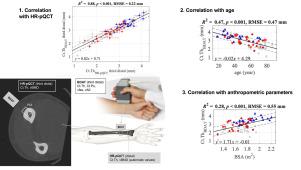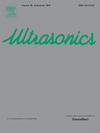Cortical bone parameters measured at the one-third distal radius obtained with axial transmission and HR-pQCT compared with anthropometric data in a representative population
IF 4.1
2区 物理与天体物理
Q1 ACOUSTICS
引用次数: 0
Abstract
Fragility fractures remain an important health issue, in the context of aging populations. Ultrasonic measurement of cortical bone thickness (Ct.Th) and porosity (Ct.Po) at peripheral sites (forearm or leg) has been shown to be predictive of non-vertebral fragility fractures, with performance comparable with X-ray gold standard (DXA). Ultrasonic parameters (Ct.Th and Ct.Po) were measured using a Bi-Directional Axial Transmission (BDAT) device at the one-third distal radius. These values were validated, compared with site matched measurement of Ct.Th and volumetric Bone Mineral Density (Ct.vBMD) obtained with High Resolution peripheral Computed Tomography (HR-pQCT). Sixty-six participants (41 women, 25 men), aged 18 to 87 years old, with Body Mass Index (BMI) ranging from 16 to 30 kg.m−2, were included. Significant linear correlations () were observed considering regular measurements: Ct.Th decreases with age and increases with Body Surface Area (BSA), height and weight. Opposite variations were observed for Ct.Po. Irregular measurements were associated with significantly older participants ( vs y.o.) and with thinner ( vs ) and more porous ( vs %) cortical bone with respect to regular measurements (), while no significant differences were observed for other anthropometric data. It suggests that measurement irregularities can be associated with the trabecularization process. The integration of these reference values, with respect to anthropometric data (height, weight, BSA), should improve the detection of people at risk of fragility fractures using ultrasonic devices.

通过轴向传输和HR-pQCT测量桡骨远端三分之一处的皮质骨参数,并与代表性人群的人体测量数据进行比较
在人口老龄化背景下,脆弱性骨折仍然是一个重要的健康问题。超声测量外周部位(前臂或腿部)的皮质骨厚度(Ct.Th)和孔隙度(Ct.Po)已被证明可以预测非椎体脆性骨折,其性能与x射线金标准(DXA)相当。超声参数(Ct。Th和Ct。使用双向轴向传输(BDAT)装置在桡骨远端三分之一处测量Po值。将这些值与Ct的位置匹配测量值进行比较,验证了这些值。高分辨率外周计算机断层扫描(HR-pQCT)获得骨矿物质密度和体积骨密度(Ct.vBMD)。66名参与者(41名女性,25名男性),年龄在18至87岁之间,身体质量指数(BMI)在16至30 kg.m - 2之间。考虑到常规测量,观察到显著的线性相关性(p<0.01): Ct。随着年龄的增长而降低,随着体表面积(BSA)、身高和体重的增加而增加。Ct.Po则相反。与常规测量值(p<0.002)相比,不规则测量值与受试者年龄明显相关(71±10 vs 49±17),与更薄(2.3±0.5 vs 3.2±0.6mm)和更多孔(10.9±3.5 vs 8.6±3.3%)的皮质骨相关(p<0.002),而在其他人体测量数据中没有观察到显著差异。这表明测量的不规则性可能与小梁化过程有关。将这些参考值与人体测量数据(身高、体重、BSA)相结合,可以提高超声设备对脆性骨折危险人群的检测。
本文章由计算机程序翻译,如有差异,请以英文原文为准。
求助全文
约1分钟内获得全文
求助全文
来源期刊

Ultrasonics
医学-核医学
CiteScore
7.60
自引率
19.00%
发文量
186
审稿时长
3.9 months
期刊介绍:
Ultrasonics is the only internationally established journal which covers the entire field of ultrasound research and technology and all its many applications. Ultrasonics contains a variety of sections to keep readers fully informed and up-to-date on the whole spectrum of research and development throughout the world. Ultrasonics publishes papers of exceptional quality and of relevance to both academia and industry. Manuscripts in which ultrasonics is a central issue and not simply an incidental tool or minor issue, are welcomed.
As well as top quality original research papers and review articles by world renowned experts, Ultrasonics also regularly features short communications, a calendar of forthcoming events and special issues dedicated to topical subjects.
 求助内容:
求助内容: 应助结果提醒方式:
应助结果提醒方式:


